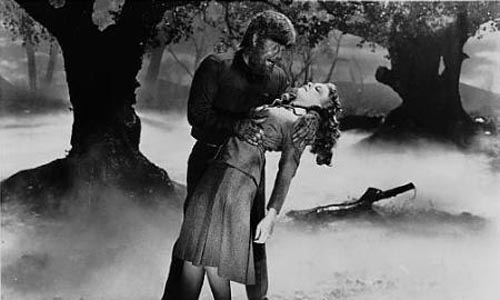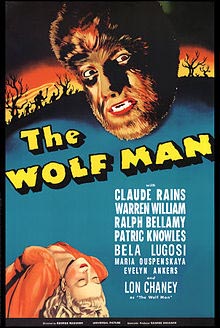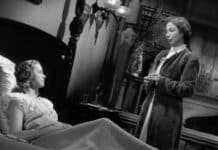The Wolf Man 1941 is howling good time making a star of Lon Chaney Jr. ADAM SCOVELL reviews the Universal Horror classic.

TITLE: The Wolf Man
YEAR RELEASED: 1941
DIRECTOR: George Waggner
CAST: Lon Chaney Jr, Claude Rains, Bela Lugosi, Ralph Bellamy and Warren William
PLOT: Larry Talbot, a man who has spent many years in America, returns to his native Wales and is attacked by a werewolf becoming a lycanthrope himself
MORAL OF THE STORY: “Even a man who is pure in heart and says his prayers by night, may become a wolf when the wolfbane blooms and the autumn moon is bright.”
FUN FACT: The silver top of Larry’s wolf-head cane was made of vulcanized rubber so none of the actors or stunt doubles would get injured if they were accidentally hit by it.
One of Universal’s best efforts within the gothic tradition, 1941’s The Wolf Man is one of the studio’s best horror films from its golden era.
Though its director isn’t well known for his horror, the success of this feature is no doubt down to borrowing certain stylistic elements from Universal’s most innovative horror director, James Whale.
George Waggner’s film could easily be a Whale film, both stylistically and narrative wise with dialogue being laced with humour and delicious lines of pathos. This however isn’t just another monster film or the sort that Universal would start pouring out only a few years later.
The Wolf Man 1941 concerns the fate of Larry Talbot, the son of the rich owner of Talbot castle in an area surrounded by myth and folklore about lycanthropic happenings. Lon Chaney Jr. gives a startlingly effective performance as the tortured and tragic figure of Talbot as he becomes infected after being bitten by a werewolf while trying to save a local girl from an equally awful fate. Chaney is perhaps one of genres most underrated actors, most probably due to his father’s success so seeing a full blooded performance from the man is exhilarating.
Talbot’s character does start off the film being a tad strange, almost a slimy character with his frankly odd and stalker like chat up lines used on local girl Gwen. When a group of Gypsies arrive in town, they bring with them the old curse of the werewolf. Not exactly politically correct but this does produce some wonderfully dated and unintentionally humorous lines from some of the supporting cast such as “Wolf!? Gypsy woman!? Murder!? What is this!?”.
Bela Lugosi’s presence is barely felt in the film, though his name was no doubt used to draw people in to the cinemas. He plays a gypsy called Bela and one can’t help but feel this was the studio having its own laugh on the poor actor as he increasingly struggled to find work at a decent rate. This awkwardness is thankfully avoided further as he leaves the film relatively early on.
The visuals of The Wolf Man 1941 are also something effective and atmospheric. Though the actual design and make up job of the wolf man himself is rendered almost ineffectual after a viewing of Carry on Screaming, the sets and lighting in particular are some of the best Universal ever produced. Though set in Wales, this is pure Conan Doyle country, full of dark foggy evenings on the countryside and eerie towns, wonderfully realised and shot with a keen eye for atmosphere.
Though slightly short, The Wolf Man 1941 can more than hold its weight against Universal’s more iconic films. Though the creature itself would eventually share the same fate as Frankenstein and Dracula with rash of poor sequels, the original film is one of the best early horror films out there and is as effective a piece a cinema as Universal ever produced.
What did you think of The Wolf Man 1941? Tell us in the comments section below!








